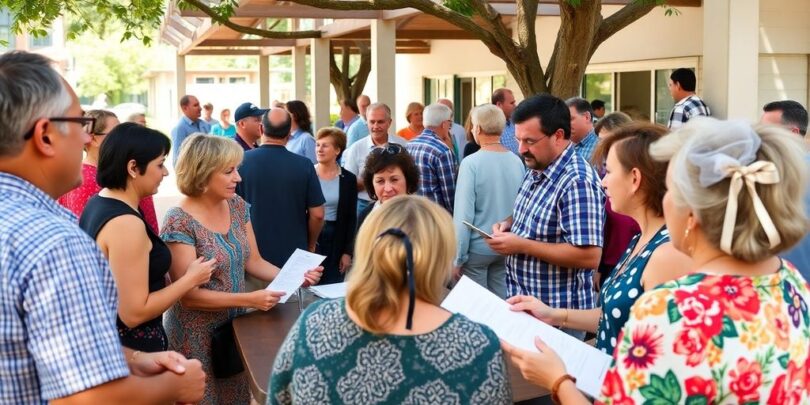Participatory budgeting is gaining traction in Australia as a way for communities to have a say in how local funds are spent. This approach not only empowers residents but also aims to create a more transparent and accountable government. In this article, we will explore what participatory budgeting means for community engagement, how local governments are involved, and the challenges and successes seen across the country.
Key Takeaways
- Participatory budgeting allows communities to influence local budget decisions.
- Local governments face challenges in implementing participatory budgeting effectively.
- Community engagement methods vary widely, impacting the success of participatory budgeting.
- Building trust through transparency is essential for effective participatory budgeting.
- Future developments in participatory budgeting could lead to broader adoption and innovation in local governance.
Understanding Participatory Budgeting in Australia
Definition and Origins of Participatory Budgeting
Okay, so what’s this participatory budgeting (PB) thing all about? Basically, it’s where the community gets a say in how public money is spent. Instead of just letting the council decide everything behind closed doors, PB opens up the process and lets residents pitch ideas and vote on projects. Think of it as democracy in action, but for your local budget. The first PB process kicked off in Porto Alegre, Brazil, back in 1989. It was all about giving people more power after a period of authoritarian rule. From there, it spread like wildfire through South America, and eventually made its way to places like Europe, North America, and now, Australia.
Key Principles of Participatory Budgeting
PB isn’t just about letting people vote on stuff. There are some core principles that make it work. Here are a few:
- Transparency: Everything needs to be open and easy to understand. No hiding dodgy deals in the fine print.
- Inclusivity: Everyone should have a chance to participate, no matter their background or where they live.
- Equity: PB should aim to address inequalities and make sure resources are distributed fairly.
- Deliberation: It’s not just about voting; it’s about discussing ideas, weighing up options, and making informed decisions.
Participatory budgeting is more than just a process; it’s a commitment to empowering communities and building a more democratic society. It’s about trusting people to make decisions about their own neighbourhoods and giving them the resources to do so.
Global Context and Comparisons
Australia was a bit late to the party, with the first documented process occurring in 2012. While we’ve borrowed ideas from other countries, we’re also doing our own thing. For example, some councils might allocate a small portion of their budget to PB, while others might go all-in and let the community decide on major projects. It’s interesting to see how different councils are adapting the practise to suit their own needs. The table below shows the variation in the budget available to the community for decision-making:
| City | Budget Available | Timeframe | Engagement Methods |
|---|---|---|---|
| City of Melville | $100,000 | 1 year | Workshops |
| City of Melbourne | $5.9 billion | 10 years | Community panels, citizens’ juries |
The Role of Local Governments in Participatory Budgeting
Local Government Initiatives
Local councils are really getting into participatory budgeting (PB) here in Australia. It’s becoming a popular way for them to involve residents in deciding how public money is spent. You see councils running workshops, setting up online forums, and even doing good old-fashioned community meetings to get input. The idea is to make sure everyone has a say, not just the usual suspects. Some councils allocate a specific portion of their budget for PB projects, while others use it for smaller, community-based initiatives. It’s all about giving locals a chance to shape their neighbourhoods and towns. For example, councils might use PB to decide on park upgrades, new playgrounds, or even community art projects. It’s a pretty cool way to see democracy in action, right in your own backyard.
Challenges Faced by Local Councils
Implementing participatory budgeting isn’t always a walk in the park for local councils. One of the biggest hurdles is getting a diverse range of people involved. It’s easy for the same voices to dominate, so councils have to work hard to reach out to different groups, especially those who might not usually engage with local government. Another challenge is managing expectations. Sometimes, the community comes up with ideas that are just not feasible, either because of budget constraints or practical limitations. Councils need to be upfront about what’s possible and what’s not, which can be a tricky balancing act. Then there’s the issue of resources. Running a PB process takes time and effort, and councils need to make sure they have the staff and systems in place to do it properly. It’s a learning curve for everyone involved, but the potential benefits make it worth the effort.
Case Studies of Successful Implementations
There are some great examples of participatory budgeting working well in Australia. One council in Melbourne allocated a significant amount of money over ten years through PB, letting residents decide on major infrastructure projects. Another council in Western Australia used PB to fund smaller community grants, empowering local groups to bring their ideas to life. What makes these initiatives successful? Well, it’s usually a combination of factors. Strong leadership from the council, a clear and transparent process, and genuine community engagement are all key. It’s also important to have good communication, so everyone knows what’s happening and why. These case studies show that PB can be a powerful tool for building stronger, more connected communities, but it needs to be done right. Councils need to be willing to listen, learn, and adapt to the needs of their residents.
Participatory budgeting is not just about allocating funds; it’s about building trust and fostering a sense of ownership within the community. When people feel like they have a say in how their money is spent, they’re more likely to be engaged and invested in their local area.
Here’s a quick look at some key differences in PB implementation across different councils:
| Council | Budget Allocation | Timeframe | Engagement Methods |
|---|---|---|---|
| City of Melville | $100,000 | 1 year | Workshops, Community Panels |
| City of Melbourne | $5.9 billion | 10 years | Citizens’ Juries, Online Forums |
It’s interesting to see how different councils approach PB, and what works best for their communities. Understanding activity-based budgeting can help councils allocate resources effectively during participatory budgeting processes.
Community Engagement Strategies in Participatory Budgeting
Methods of Community Involvement
Okay, so when it comes to getting everyone involved in participatory budgeting (PB), there’s a bunch of ways to go about it. It’s not just about chucking a survey online and hoping for the best. Think about it – you need to reach people where they are, and that means using a mix of approaches. Some councils run good old-fashioned town hall meetings, which, let’s be honest, can be a bit of a drag, but they do give people a chance to voice their opinions face-to-face. Others use online platforms, which are great for reaching a wider audience, especially younger folks. And then there are workshops, community panels, and even stuff like pop-up stalls at local markets. The key is to make it accessible and inviting, not some bureaucratic nightmare. It’s also important to provide information in different languages and formats to cater to diverse communities.
Here’s a few common methods:
- Online Surveys: Quick and easy way to gather broad input.
- Community Workshops: Facilitated sessions for in-depth discussion.
- Public Forums: Open meetings for presentations and Q&A.
- Pop-Up Events: Engaging people in everyday locations.
Deliberative Processes and Their Importance
Deliberative processes are super important in PB. They’re all about giving people the time and space to really think about the issues, weigh up the options, and come to informed decisions. It’s not just about voting for whatever sounds good at first glance. Deliberation involves things like providing participants with detailed information, facilitating discussions, and encouraging them to consider different perspectives. This can lead to better outcomes because people are making decisions based on a solid understanding of the facts, not just gut feelings. Some councils even use citizens’ juries, where a randomly selected group of residents spends several days learning about the budget and then makes recommendations. It’s a pretty cool way to ensure that decisions are fair and representative. The Community Engagement & Participation Strategy adoption shows the importance of these processes.
Deliberative processes are designed to allow space and time for participants to test assumptions, question sources, set criteria, deliberate and form consensus and given the complexity of the work and spending of local government, this is important.
Barriers to Effective Engagement
Alright, let’s be real – getting everyone properly engaged in PB isn’t always a walk in the park. There are definitely some hurdles to overcome. One big one is just getting people to care. A lot of people feel like their voice doesn’t matter, or that the council will just do whatever it wants anyway. So, you need to build trust and show them that their input is actually valued. Another barrier is accessibility. Not everyone has the time, resources, or skills to participate. You need to make sure that the process is inclusive and caters to people from all walks of life. And then there’s the issue of information overload. Budget documents can be pretty dense and confusing, so you need to present the information in a clear and easy-to-understand way. Overcoming these barriers requires a commitment to transparency, accessibility, and genuine community partnership. It’s about creating a PB process that is truly by the people, for the people. The first PB process was in Brazil.
Impact of Participatory Budgeting on Community Trust
Building Trust Through Transparency
Participatory budgeting (PB) can really change how people see their local council. The key is transparency. When the community gets to decide where the money goes, it’s not just about getting a new park or fixing a road. It’s about seeing how the sausage is made, so to speak. This openness can help build trust in the council, because people can see that decisions aren’t being made behind closed doors. It’s a chance to show that the council is actually listening and acting on what the community wants. This is especially important given that trust in public institutions is essential for effective governance.
Enhancing Civic Participation
PB isn’t just about deciding on projects; it’s about getting more people involved in local government. It’s a way to get people off the couch and into the town hall (or, more likely, onto a Zoom call these days). When people feel like they have a say, they’re more likely to pay attention to what’s happening in their community. This can lead to:
- More people voting in local elections.
- More people volunteering for community groups.
- More people speaking up about local issues.
It’s not a silver bullet, but PB can be a good way to get people more engaged in their community and to feel like they have a stake in what happens.
Long-term Effects on Community Relations
If PB is done right, it can have a lasting impact on how people feel about their community and their council. It’s not just about getting a few projects funded; it’s about building stronger relationships between the council and the community. Over time, this can lead to a more cohesive and engaged community, where people feel like they’re all working together to make their area a better place. It can also help to break down some of the cynicism and distrust that people often feel towards government. The spread throughout South America shows the potential for positive change. It’s about creating a sense of shared ownership and responsibility for the future of the community.
Evaluating the Effectiveness of Participatory Budgeting

Metrics for Success
So, how do we actually know if participatory budgeting (PB) is working? It’s not just about feeling good; we need some solid ways to measure its impact. One key metric is the level of community participation itself. Are more people getting involved over time? Are diverse groups represented? We also need to look at the types of projects that get funded. Are they addressing real community needs, or are they just popular ideas that don’t make a big difference? Another thing to consider is the efficiency of the process. Is it costing too much to run compared to the benefits it brings? These are all important questions to ask when figuring out if PB is a success.
Comparative Analysis of Different Models
Not all PB is created equal. There are different ways to run these things, and some work better than others. For example, some councils might use online voting, while others rely on community workshops. Some might give the community a lot of say over a small pot of money, while others offer less control over a larger budget. To really understand what works, we need to compare these different models. We can look at things like:
- How many people participate in each model.
- The types of projects that get funded.
- The cost of running each model.
- The level of satisfaction among participants.
By comparing these factors, we can start to figure out which PB models are the most effective in different contexts. It’s not a one-size-fits-all kind of thing, so we need to be flexible and adapt our approach to suit the local community.
Feedback Mechanisms and Community Input
PB shouldn’t be a one-way street. It’s not enough to just ask people what they want and then disappear. We need to create ways for the community to give feedback on the process itself. This could involve surveys, public forums, or even just informal chats with council staff. The important thing is to listen to what people are saying and use that feedback to improve the way PB is run. For example, if people are finding the online voting system confusing, we need to fix it. If they feel like their voices aren’t being heard, we need to find ways to make the process more inclusive. It’s all about continuous improvement and making sure that PB is truly responsive to the needs of the community. It’s important to consider the challenges faced by local councils when implementing these feedback mechanisms.
Making sure the community has a say after the budget is allocated is just as important as getting their input beforehand. It’s about closing the loop and showing people that their voices matter. This helps build trust and encourages more people to get involved in the future.
Future Directions for Participatory Budgeting in Australia
Emerging Trends and Innovations
Alright, so what’s next for participatory budgeting (PB) down under? Well, it’s not just about sticking to the same old methods. We’re seeing some cool new stuff pop up. Think more digital platforms to get more people involved, especially those who can’t make it to town hall meetings. There’s also a push for better ways to track how the money’s actually spent and what impact it has. It’s all about making the process more accessible and, importantly, more transparent. The integration of digital tools is set to revolutionise community engagement in PB.
- Using online platforms for idea submission and voting.
- Implementing real-time budget tracking dashboards.
- Employing data analytics to identify community needs.
Potential for Expansion in Local Governments
PB is still finding its feet in many Aussie councils. Some have jumped in headfirst, while others are still dipping their toes. The potential for growth is massive, though. Imagine if every council had a chunk of its budget decided by the community! It could really change how local governments operate and how people feel about them. But, of course, it needs to be done right. Councils need to be willing to give up some control and trust the process. It’s a big shift, but one that could pay off big time. The bottom up budgeting approach can be a great way to get started.
Recommendations for Best Practises
So, how do we make sure PB works well and doesn’t just become another box-ticking exercise? A few things are key. First, get the community involved early and often. Don’t just ask for ideas at the last minute. Second, be transparent about the budget and how decisions are made. No one likes feeling like they’re being kept in the dark. Third, make sure everyone has a fair go. That means reaching out to different groups and making sure their voices are heard. And finally, learn from what others have done. There are plenty of examples out there, both good and bad. Let’s not reinvent the wheel, eh?
It’s important to remember that participatory budgeting isn’t a one-size-fits-all solution. What works in one community might not work in another. It’s all about adapting the process to fit the local context and needs.
Challenges and Critiques of Participatory Budgeting

Resource Allocation and Sustainability
One of the big questions hanging over participatory budgeting (PB) is whether it’s actually sustainable in the long run. It’s all well and good when there’s plenty of cash to splash, but what happens when budgets get tight? There’s a real risk that PB gets canned when councils are forced to make tough decisions about where the money goes.
- Can PB projects continue to be funded in times of economic downturn?
- How do we ensure that PB doesn’t just become a way to fund pet projects that don’t address core community needs?
- What happens when community priorities clash with essential services?
It’s important to remember that PB isn’t a magic bullet. It’s a tool, and like any tool, it needs to be used carefully and strategically. If not, it can end up creating more problems than it solves.
Political Resistance and Public Perception
Getting everyone on board with PB can be a real battle. Some politicians and council staff might see it as a threat to their power, and they might resist giving up control over budget decisions. Plus, there’s always the risk that the public just won’t be that interested, or that they’ll see it as a waste of time. Overcoming political resistance is a key challenge.
- How do we convince politicians and council staff that PB is a good thing?
- How do we get the public engaged and interested in PB?
- How do we deal with the inevitable complaints and criticisms that will come with any PB process?
Addressing Inequities in Participation
PB is meant to be about giving everyone a voice, but the reality is that some people are always going to be louder than others. It’s easy for PB processes to be dominated by certain groups, leaving others feeling left out and ignored. Making sure everyone has a fair go is crucial. We need to think about how to get those quieter voices heard and ensure equitable participation.
- How do we ensure that PB processes are accessible to everyone, regardless of their background or circumstances?
- How do we encourage participation from marginalised groups?
- How do we make sure that everyone’s voice is heard and valued?
Wrapping Up: The Future of Participatory Budgeting in Australia
In conclusion, participatory budgeting is shaking things up in local government across Australia. It’s not just about numbers; it’s about getting people involved in decisions that affect their lives. Sure, there are bumps along the way, like differing budgets and the challenge of keeping everyone engaged. But the potential for real community involvement is huge. As more councils jump on board, we might see even more creative ways to include public input in budgeting. It’s clear that while there are challenges, the benefits of participatory budgeting could lead to stronger communities and better local governance. So, here’s hoping that this trend continues to grow and evolve in the years to come.
Frequently Asked Questions
What is participatory budgeting?
Participatory budgeting is a way for local communities to have a say in how part of their government budget is spent. It started in Brazil in 1989 and is now used in many places, including Australia.
How does participatory budgeting work in Australia?
In Australia, local councils set aside a portion of their budget for community input. Residents can suggest projects and vote on which ones should be funded.
Why is community engagement important in budgeting?
Community engagement helps ensure that the needs and wants of local people are considered in budget decisions. It can also build trust between the government and the community.
What challenges do local councils face with participatory budgeting?
Local councils may struggle with resources, public interest, and managing expectations. Sometimes, political issues can also make it hard to implement these processes.
Are there examples of successful participatory budgeting in Australia?
Yes, there are several successful examples in Australia, such as in Melbourne and the City of Melville, where residents have effectively influenced local spending.
What are the future prospects for participatory budgeting in Australia?
As more councils see the benefits, participatory budgeting is likely to grow. There is potential for more councils to adopt it and for existing processes to improve.








